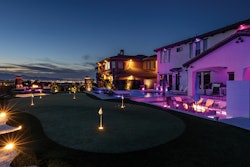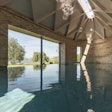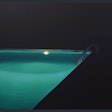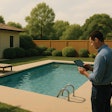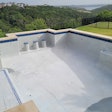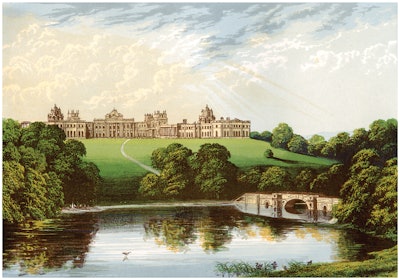
If you were to visit Croome Park in Worcestershire, England, you would cross paths with a remarkable water feature designed in the late 18th century by one of the best-known early landscape designers, Lancelot “Capability” Brown. As you explore, Croome River appears to meander naturally through the parkland. That river, however, is an artfully constructed lake that was built not only to offer the best views but also to solve the estate’s drainage problems.
When Brown designed plans for his clients, he persuaded them to undertake such large-scale projects by riding around the property on horseback, quickly devising a plan and describing to his clients the improvements he would make — and how they would enjoy them. Whether creating a river, moving an entire village to change the owner’s view, or building sunken walls as “illusions” meant to trick the viewer into believing the property extended endlessly, Brown understood that persuading clients to accept his plans meant helping them see exactly how each change would benefit them. His flair for crafting a compelling story was so well-recognized that poets even wrote about his work: “He speaks. The lake in front becomes a lawn.”[1]
In the more than 260 years since Brown completed that narrow river, design trends have come and gone, but the importance of sharing with clients a design that is not just beautiful but also creates an emotional connection remains just as important now as it was then. As Brown would have agreed, homeowners aren’t renovating their outdoor living spaces merely for the sake of water or concrete. What they want is to enjoy time with family, entertain their friends, and transform their yard into a private retreat. Creating an emotional connection helps the client understand exactly why a design is perfect for their needs.
DESIGN A STORY
Capability Brown so clearly understood the usefulness of storytelling techniques that he is said to have explicitly compared his design process to writing: “there...I make a comma, and there...where a more decided turn is proper, I make a colon; at another part, where an interruption is desirable to break the view, a parenthesis; now a full stop, and then I begin another subject.”[2] What Brown’s talent for creating beautiful illusions — like an ingenious “river” whose end is hidden by trees — reflects is his understanding that his clients needed outdoor living spaces that would be both beautiful and functional, perhaps even as much to impress their visitors as to solve their structural problems. His knack for persuading clients to choose
his designs, however, hinged on his ability to understand how his clients would use their properties and what they cared about the most.
Identifying what is important to a client, however, can be challenging. Brown’s humorous comparison of elements of his designs to punctuation aside, the process of designing a space that not only meets a client’s needs but also suits their lifestyle and taste can seem to leave little time for also crafting a personalized, unique story about the client. An internet search for tips on “how to tell a story” can raise more questions than it answers, and many who are faced with the prospect of drafting a story often hesitate, perhaps suffering writer’s block or feeling limited by the formal rules half-remembered from school.
RELATED: Want To Improve Your Pool Projects? Study The History Of Art And Architecture
We can look to the past for instruction and inspiration. Many of the earliest and most famous advertising experts — from Claude C. Hopkins to David Ogilvy — often succeeded by building a story about the product they were selling. Whether advertising orange juice or beer, soap or luxury cars, they shaped their ads to help their audience understand exactly why the product was the right choice. As Hopkins demonstrated, such a story does not need to be complex or complicated. In fact, Hopkins made Schlitz Beer the leading brand by telling a very simple story: Instead of simply saying that the beer was pure, Hopkins explained how the beer was brewed to keep it pure.[3] He was able to do so because he took the time to analyze what intrigued his audience. Ogilvy reinforced the value of this approach when he famously said, “I don’t want you to tell me that you find it ‘creative.’ I want you to find it so interesting that you buy the product.”[4]
To shape a personalized story that clients find equally compelling, it helps to take the time to learn as much as possible about the clients. Good questions will cover the basics: What do they like, and what do they want to change about their outdoor living space? Invite the client to go into depth:
– Do they have kids and maybe a dog? If so, do they want a yard where all the neighborhood kids will come to play? Or do they want a private place where their kids (and the family dog) can play safely?
– What do they enjoy about their home? How is their home decorated, and how did they choose that style? If a prominent art piece or decoration is on display, how did they choose it and where is it from?
CREATE EMOTIONAL CONNECTIONS
In the centuries since Brown toured his clients’ estates on horseback, advances in technology have made it both faster and easier to assess an outdoor living space and create a design. With the advent of new technology, designs that would once have taken days if not weeks now take mere hours, freeing designers to add features and elements that connect the client to the design. Tools like 3D design software not only significantly shorten the design time but also make it easier to add personalized elements that designers like Brown could only have imagined, including gentle water sounds that lead the client to discover the water features in an interactive 3D presentation or even the sight of the family dog relaxing on the pool’s Baja shelf that gives the client a sense of scale.
However, many of the problems that designers today are called upon to solve are remarkably similar to those faced by their predecessors. In fact, more than a century and a half before the very first 3D swimming pool design would be presented to a conference room full of Arizona pool builders, the Victorian artist Henry Fox Talbot was attempting to solve a problem similar to that which many of those same pool designers were seeking new ways to approach: how best to capture the full scope of a beautiful outdoor scene.
Talbot had been so inspired by the beautiful views he was enjoying during his 1833 visit to Lake Como in Italy that he attempted to sketch what he saw. Try as he might, however, he couldn’t capture the lake’s full beauty with just pencil and paper. When he traced what he saw through a camera lucida, his “faithless pencil,” he wrote, “only left traces.”[5] In order to capture the beautiful views of nature he saw, he was inspired to invent a new way of doing so, experimenting with light, chemicals and paper to create photographs.
RELATED: Who Are The Pool Design Masters?
Talbot’s quest to capture lasting views of nature suggests an intriguing opportunity for designers today. After all, it was not merely a beautiful scene that inspired him. When he attempted to preserve the images of Lake Como, he was on his honeymoon. And ever since that first 3D swimming pool design was shared in 1999, pool designers have been discovering new ways to make 3D pool designs just as personal and even inspirational. With the development of detailed and extensive 3D object libraries, for example, it’s now possible to not just add any dog to the client’s new pool — a designer can add a dog that looks just like the client’s own, right along with the client’s beloved vintage car parked in the driveway and favorite flowers blooming in the planter boxes.
 The same scene as the painting at the top, but photographed today from a different vantage point.Photo courtesy Shutterstock
The same scene as the painting at the top, but photographed today from a different vantage point.Photo courtesy Shutterstock
SHARE YOUR IDEAS
At the same time that Talbot was inventing one form of photography, he was already looking forward to future improvements: “When we have learnt more, by experience, respecting the formation of such pictures, they will doubtless be brought much nearer to perfection.” As he anticipated, “progress will be more rapid when more minds are devoted to its improvement.” Within mere decades, not only would it be possible to achieve the “completeness of detail and correctness of perspective” that Talbot imagined, but movie cameras would even make it possible to capture far more than the flowers and leaves he initially studied.
What Talbot also recognized was that a carefully framed view can reveal far more information than just the mere facts of what is being photographed: “A painter’s eye will often be arrested where ordinary people see nothing remarkable.” That expert ability to highlight more than the untrained “eye” can see is often what differentiates a great design from a merely good-enough one. The goal is not just to design a story — it’s to design for story. Shaping the personalized story along with the unique design does more than serve to introduce the client to the project plans; it also helps to create the emotional connection that inspires the client to choose that design for their space.
[1] William Cowper, “The Task: A Poem, in Six Books,” 1785
[2] Rosemary Hill, “As God Intended,” (London Review of Books, November 7, 2019), https://www.lrb.co.uk/the-paper/v34/n01/rosemary-hill/as- god-intended
[3] Noah Nehlich, Design for Story: Create Immersive Outdoor Living Experiences (p. 17). Kindle Edition
[4] David Ogilvy, Ogilvy on Advertising (New York: Vintage, 1983)
[5] Henry Fox Talbot, The Pencil of Nature (London: Longman, Brown, Green and Longmans, 1844)
Noah Nehlich, author of Design for Story: Create Immersive Outdoor Living Experiences, is the founder of 3D design software company Structure Studios. For the past two decades, Noah has helped thousands of designers, builders, and salespeople leverage 3D design tools to amaze their clients and achieve their business goals by teaching that great designs offer far more than concrete and water: they create an emotional connection. His goal is to improve lives through 3D experiences.
This article first appeared in the October 2021 issue of AQUA Magazine — the top resource for retailers, builders and service pros in the pool and spa industry. Subscriptions to the print magazine are free to all industry professionals. Click here to subscribe.



























